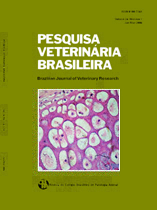 |
|
|
|
Ano 2014 - Volume 34, Número 6
|

|
Comparação da composição bioquímica do líquido amniótico equino colhido em diferentes estágios gestacionais e no momento do parto, 34(6):582-588
|
RESUMO.- De Vita B., Campos L.L., Listoni A.J., Martin I., Takahira R.K., Curcio B.R., Landim-Alvarenga F.C. & Prestes N.C. 2014. [Comparison of the biochemical composition of equine amniotic fluid collected in different gestational phases and at delivery.] Comparação da composição bioquímica do líquido amniótico equino colhido em diferentes estágios gestacionais e no momento do parto. Pesquisa Veterinária Brasileira 34(6):582-588. Departamento de Reprodução Animal e Radiologia Veterinária, Faculdade de Medicina Veterinária e Zootecnia, Universidade Estadual Paulista, Distrito de Rubião Júnior s/n, Botucatu, SP 18618-970, Brazil. E-mail: bruddev@gmail.com
A viabilidade e maturidade fetais podem ser estimadas através da avaliação dos fluídos fetais em muitas espécies, no entanto a composição bioquímica do líquido amniótico durante a gestação ainda não está bem definida para a espécie equina. O objetivo deste estudo foi estabelecer e comparar o perfil bioquímico do liquido amniótico em diferentes momentos da gestação e no momento do parto para um melhor entendimento da fisiologia da gestação de equinos. Foram avaliados valores encontrados para pH, osmolaridade, glicose, uréia, creatinina, gamma-GT, sódio, potássio, cloretos e proteína total no liquido amniótico colhido de 122 éguas comparando-se os resultados encontrados entre as colheitas em terço inicial (TI), médio (TM) e final (TF) da gestação e no momento do parto (MP). As amostras colhidas nos períodos gestacionais foram realizadas em frigoríficos abatedouros. As idades gestacionais (IG), em dias, foram definidas através de fórmula de regressão sugerida por Naves et al. (2008), utilizando-se a mensuração crânio-caudal dos fetos. Devido a presença de graus variados de assimetria e desvios de um padrão Gaussiano de distribuição, o teste de Kruskal-Wallis foi usado para comparar a mediana de cada variável-resposta entre os grupos de estudo. Quando houve evidência significante de que pelo menos uma das medianas era diferente das outras, o teste de Wilcoxon foi usado para realizar comparações múltiplas entre os grupos. O método de Bonferroni foi usado para ajustar o valor-P resultante das comparações múltiplas. A análise estatística foi realizada com o procedimento PROC NPAR1WAY e significância estatística foi definida como p<0,05 .pH e osmolaridade do líquido amniótico equino não sofreram alterações significantes entre os terços gestacionais e no momento do parto. Os valores encontrados para glicose foram significativamente menores nas amostras do grupo TF e MP. As concentrações de uréia tenderam ser estatisticamente diferente em pelo menos um dos grupos estudados e foi observado um padrão crescente nas concentrações de creatinina durante as fases gestacionais, enquanto que a concentração encontrada no grupo MP foi igual a concentração encontrada no grupo TF. Valores para gamma GT diferiram apenas entre os grupos TF e MP e mais estudos devem ser conduzidos sobre sua função no liquido amniótico das espécies domésticas. Os valores de sódio e cloretos não diferiram significativamente entre os grupos estudados e as concentrações de potássio diferiram apenas entre os grupos TF e MP refletindo a manutenção do equilíbrio eletrolítico do líquido amniótico equino durante a gestação. As concentrações de proteínas totais variaram de maneira heterogênea entre os grupos, porém todos estes demonstraram baixas concentrações. Concluímos que a composição bioquímica do liquido amniótico equino varia de acordo com o desenvolvimento fetal e pode ser utilizada como mensuração da viabilidade e maturidade do feto no futuro, no entanto devido ao pequeno número de estudos conduzidos e diferenças encontradas em seus resultados, outros estudos devem ser realizados para a melhor definição do perfil bioquímico do líquido amniótico equino durante as fases gestacionais e no momento do parto. |
| |
|
|
| |
|
 |